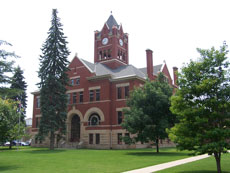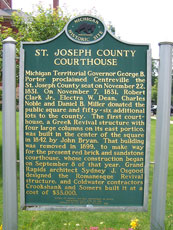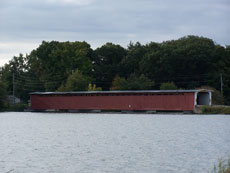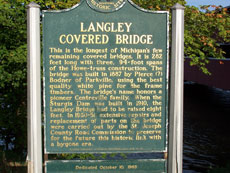
A Bit Of Centreville History
Thomas W. Langley was the first actual settler on the site of Centreville. He was born in New York in 1801, and came to Michigan in search of land. Centreville had already been platted, and was owned by several individuals. Mr. Langley purchased the entire prospective village. Within three months he completed a frame court-house (24 x 30, the largest log-house in the county for hotel purposes), a blacksmith shop, store building, a flouring and saw-mill, a post office, a school, and religious services in regular and successful operation. Mr. Langley was constantly doing something to aid in the prosperity of the village and enhance the property value.

He brought in the first stock of goods sold in Centreville, and engaged in mercantile, manufacturing, agricultural pursuits, and kept the hotel of the village. He was the first postmaster, holding that position from 1833 to 1840. Centreville was first incorporated as a village in 1837. George Talbot & Henry Cushman built the first flourmills. Mr. Langley built the dam and sold it to the mill. The mill, which first had three run of stone, was burned in 1856 and quickly rebuilt. The Centreville Roller Mills began operation in 1896. The plant had a capacity of about 100 barrels of flour every twenty-four hours. In 1872 the Centreville Knit Goods Manufacturing Company was established and became known as "Dr. Denton Sleeping Garment Mills".

The St. Joseph County Bank was chartered in the summer of 1837, followed by The Farmers and Merchants Bank in 1838. Many of the early banks failed due to flooding the market with counterfeits and discounts of genuine notes by holders. The first "solid" bank was the First National Bank, established in 1873. The Centreville Water & Electric Company was put in operation in January of 1898. The first cemetery was laid out in the village in 1833. St. Joseph County Newspaper came from Centreville, and was known as the "Peninsula": The first schoolhouse was built in 1841 located in Nottawa & Lockport counties at a cost of around five' hundred dollars. In 1841 the Methodists built the first house of worship in the village of Centreville, with the Presbyterian Church following in the fall of 1909. The Baptist Church was established in 1853, with a chapel being built in 1887. The Masons of Centreville was instituted in 1848 and chartered in January of 1849. In 1867 Nottawa station was built to serve the Grand Rapids and Indiana Railroad with their produce and mint-oil trade. Wasepi station was built in 1874 at the junction of the Michigan Central and Grand Rapids lines. Besides being a junction point, it was the shipping station for considerable cider and dried fruit.
Centreville is situated just north of the Michigan Central Railroad and south of the Prairie River, lying partly in Nottawa and partly in Lockport townships. It is in the geographical center of St. Joseph county and an ideal county seat.







